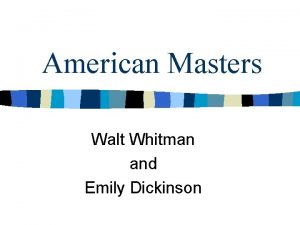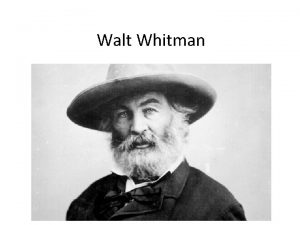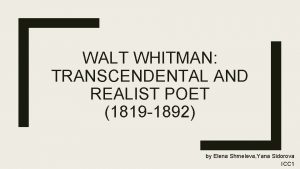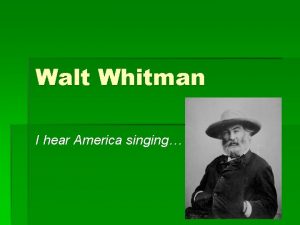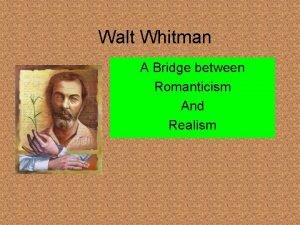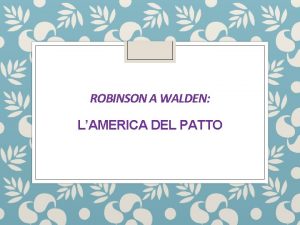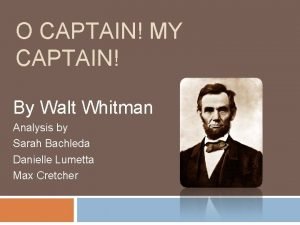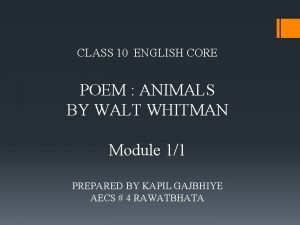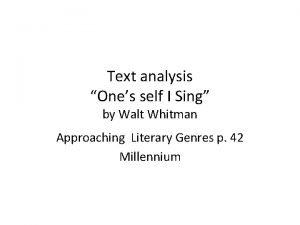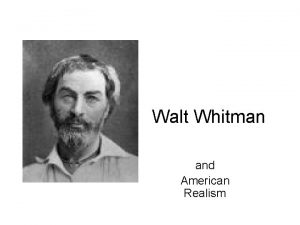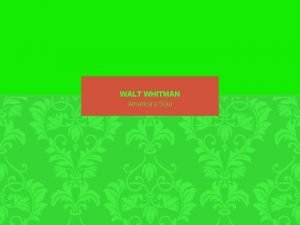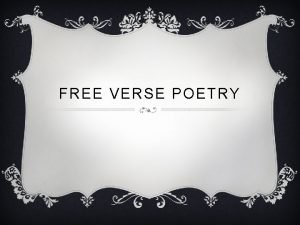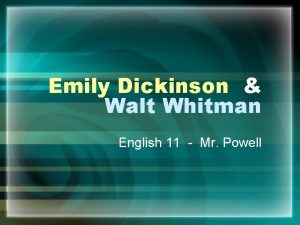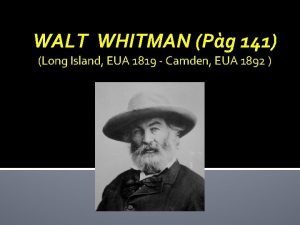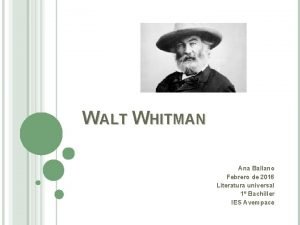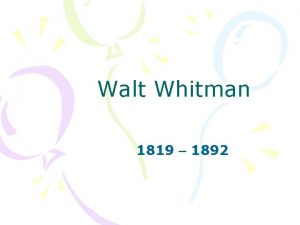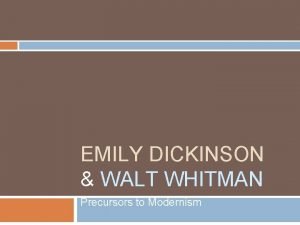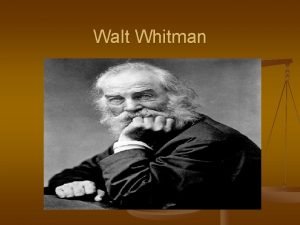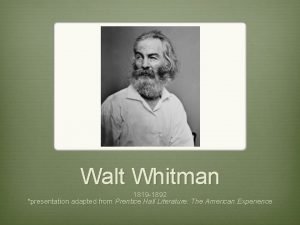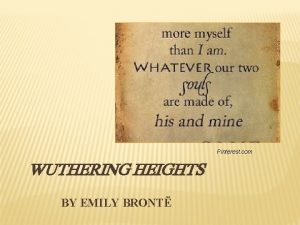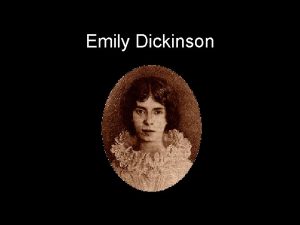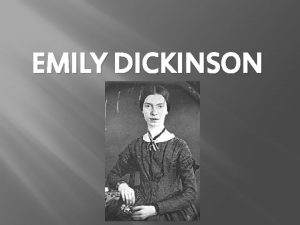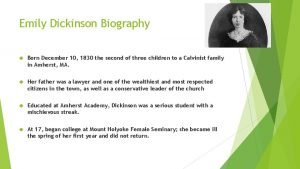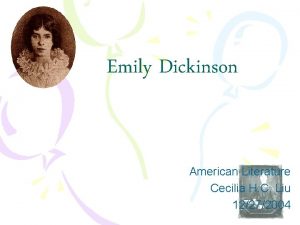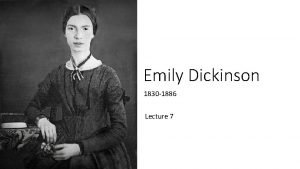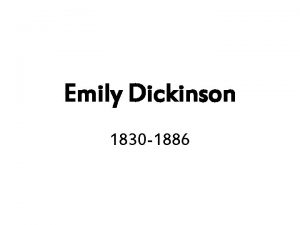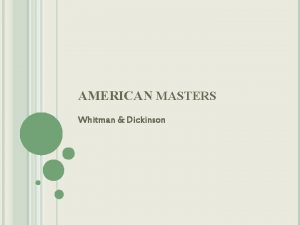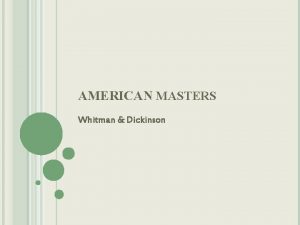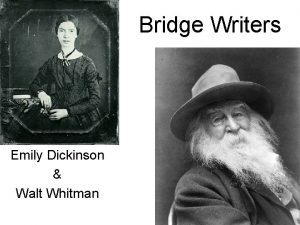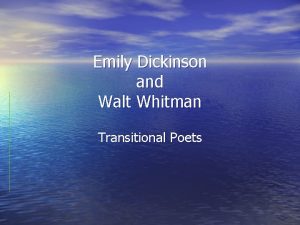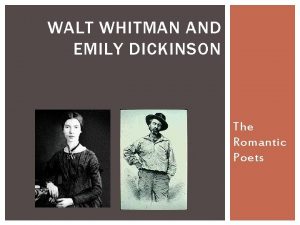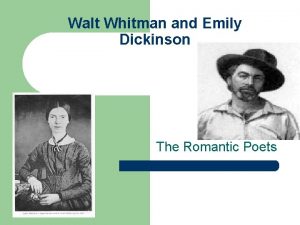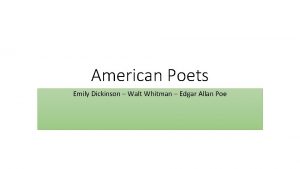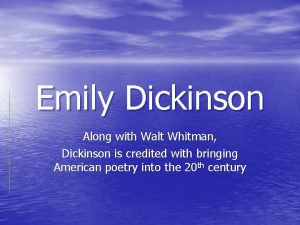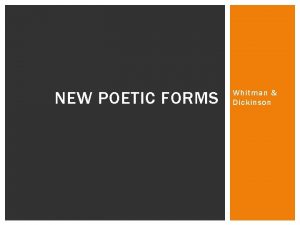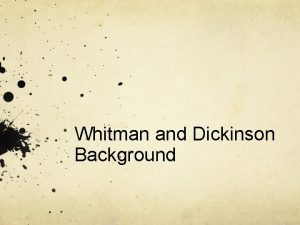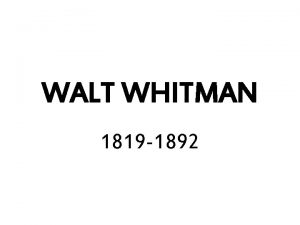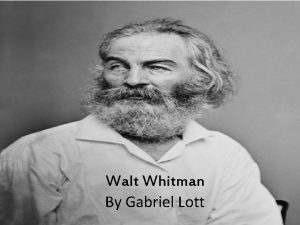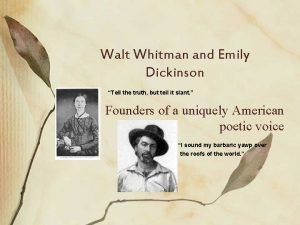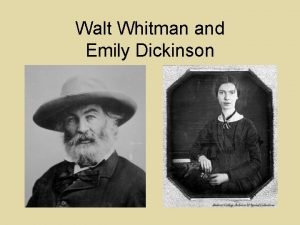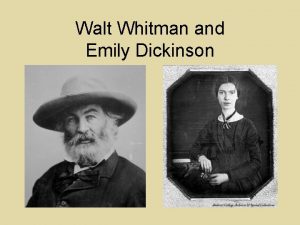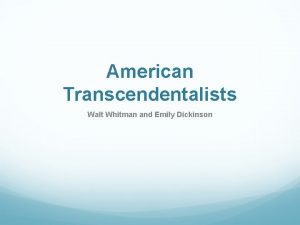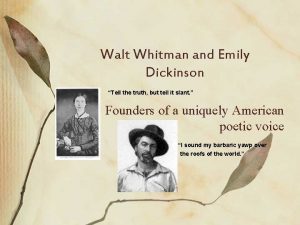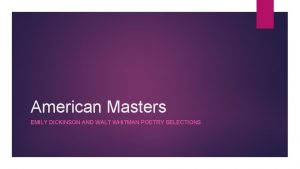Walt Whitman and Emily Dickinson The Poets and































- Slides: 31

Walt Whitman and Emily Dickinson The Poets and the Bridges

American Realism, Regionalism (Local Color), and Naturalism (1860 -1920)

Realism 1860 A. D. – 1920 A. D. Face reality as it is, not as it was or as you wish it to be. Statements they would have made: Books/Essays Lectures they would have read/heard: Names they would have known: Words connected to them: • • • The Adventures of Tom Sawyer (Twain) The Turn of the Screw (James) “Occurrence at Owl Creek Bridge” (Bierce) The Red Badge of Courage (Crane) Call of the Wild (London) § Mark Twain § Ambrose Bierce § Kate Chopin § Edward Arlington Robinson § Harriet Beecher Stowe § verisimilitude § vernacular § dialect § urbanization § industrialization § colloquialism § Jack London § Stephen Crane § Edgar Lee Masters

What is Realism? n Verisimilitude – n V-air-iss-im-ill-ah-tude n A faithful representation of reality in literature n Emphasis on development of believable characters. n Written in natural vernacular or dialect (speech). n Prominent from 1860 -1890 n Lincoln to Cleveland n Pre-Civil War to overthrow of Hawaii

From the Critics "Realism sets itself at work to consider characters and events which are apparently the most ordinary and uninteresting, in order to extract from these their full value and true meaning. It would apprehend in all particulars the connection between the familiar and the extraordinary, and the seen and unseen of human nature. Beneath the deceptive cloak of outwardly uneventful days, it detects and endeavors to trace the outlines of the spirits that are hidden there; tho measure the changes in their growth, to watch the symptoms of moral decay or regeneration, to fathom their histories of passionate or intellectual problems. In short, realism reveals. Where we thought nothing worth of notice, it shows everything to be rife with - George Parsons Lathrop, 'The Novel and its significance. " Future, " Atlantic Monthly 34 (September 1874): 313 24.

Key Traits n Renders reality closely and in comprehensive detail. Selective presentation of reality with an emphasis on verisimilitude, even at the expense of a well-made plot n Character is more important than action and plot; complex ethical choices are often the subject. n Characters appear in their real complexity of temperament and motive; they are in explicable relation to nature, to each other, to their social class, to their own past. n Class is important; the novel has traditionally served the interests and aspirations of an insurgent middle class. (See Ian Watt, The Rise of the Novel) n Events will usually be plausible. Realistic novels avoid the sensational, dramatic elements of naturalistic novels and romances. n Diction is natural vernacular, not heightened or poetic; tone may be comic, satiric, or matter-of-fact. n Objectivity in presentation becomes increasingly important: overt authorial comments or intrusions diminish as the century progresses. (from Richard Chase, The American Novel and Its Tradition)

Realist Writers n Mark Twain n Adventures of Huckleberry Finn n The Adventures of Tom Sawyer n “The Celebrated Jumping Frog of Calaveras County” n Henry James n The Turn of the Screw n Edgar Lee Masters n The Spoon River Anthology

Why did Realism develop?

Why did Realism develop?

Why did Realism develop?

Romanticism vs. Realism Romance: - Aspired to “the ideal” - Thought to be more genteel since it did not show the vulgar details of life Realism: - Thought to be more democratic (more “middle class”) - Critics stressed the potential for vulgarity and its emphasis on the commonplace - Potential “poison” for the pure of mind

Regionalism/Local Color 1860 A. D. – 1920 A. D. Bloom where ya’ll planted. No flower thrives in foreign soil. Statements they would have made: Books/Essays Lectures they would have read/heard: • • • The Awakening (Chopin) “A Worn Path” (Welty) The Sound and the Fury (Faulkner) My Antonia (Cather) Adventures of Huckleberry Finn (Twain) Names they would have known: § Mark Twain § Ambrose Bierce § Kate Chopin § Edward Arlington Robinson § Harriet Beecher Stowe Words connected to them: § vernacular § dialect § colloquialism § local color § Reconstruction § picaresque hero § Jack London § Stephen Crane § Edgar Lee Masters

Regionalism/Local Color 1860 A. D. – 1920 A. D. Words to KNOW: vernacular dialect colloquialism local color Reconstruction picaresque hero

What is Regionalism? n Often called “local color” or dialect n Focuses on characters, dialect, customs, topography, and other features specific to a certain region (e. g. the South, the West) n Coincided with Realism and sharing many of the same traits. n Prominent from 1865 -1895.

From the Critics “Regionalism's representation of vernacular cultures as enclaves of tradition insulated from larger cultural contact is palpably a fiction. . . its public function was not just to mourn lost cultures but to purvey a certain story of contemporary cultures and of the relations among them. In chronicling the nation's stories about its regions and mythical origins, local color fiction through its presence--and, later, its absence--contributed to the narrative of unified nationhood that late nineteenthcentury America sought to construct. ” - Richard Brodhead, Cultures of Letters, 121.

Key Traits n Setting: The emphasis is frequently on nature and the limitations it imposes; settings are frequently remote and inaccessible. The setting is integral to the story and may sometimes become a character in itself. n Characters: Local color stories tend to be concerned with the character of the district or region rather than with the individual: characters may become character types, sometimes quaint or stereotypical. The characters are marked by their adherence to the old ways, by dialect, and by particular personality traits central to the region. In women's local color fiction, the heroines are often unmarried women or young girls. n Narrator: The narrator is typically an educated observer from the world beyond who learns something from the characters while preserving a sometimes sympathetic, sometimes ironic distance from them. The narrator serves as mediator between the rural folk of the tale and the urban audience to whom the tale is directed. (from Richard Chase, The American Novel and Its Tradition)

Key Traits n Plots: It has been said that "nothing happens" in local color stories by women authors, and often very little does happen. Stories may include lots of storytelling and revolve around the community and its rituals. n Themes: Many local color stories share an antipathy to change and a certain degree of nostalgia for an always-past golden age. A celebration of community and acceptance in the face of adversity characterizes women's local color fiction. Thematic tension or conflict between urban ways and old-fashioned rural values is often symbolized by the intrusion of an outsider or interloper who seeks something from the community. (from Richard Chase, The American Novel and Its Tradition)

Regionalist Writers n Kate Chopin n The Awakening n "Désirée's Baby" n Mark Twain n Yep, he’s in BOTH categories!!! n Willa Cather n O Pioneers! n My Antonia

Why did Regionalism develop?

Regionalism: The Marriage of Romanticism and Realism "In local-color literature one finds the dual influence of romanticism and realism, since the author frequently looks away from ordinary life to distant lands, strange customs, or exotic scenes, but retains through minute detail a sense of fidelity and accuracy of description. ” - Oxford Companion to American Literature 439.

Naturalism 1860 A. D. – 1920 A. D. The forces of the world rule the affairs of mankind with no recognizable order. Statements they would have made: Books/Essays Lectures they would have read/heard: Names they would have known: Words connected to them: • • • “The Open Boat” (Crane) Ethan Frome (Wharton) “We Wear the Mask” (Dunbar) The Old Man and the Sea (Hemingway) “The Story of an Hour” (Chopin) § Mark Twain § Ambrose Bierce § Kate Chopin § Edward Arlington Robinson § natural selection § Darwinism § objectivity § determinism § Harriet Beecher Stowe § Jack London § Stephen Crane § Edgar Lee Masters § man in conflict with: § nature § self § society

Naturalism 1860 A. D. – 1920 A. D.

What is Naturalism? n Applied scientific principles of objectivity (impartiality) and detachment to the study of human beings. n Influenced by Darwinism (natural selection) and psychology (Freud) n Posited that men were governed by heredity and environment. n Often depict man in conflict with nature, society, or himself. n Prominent from 1880 -1920 s

From the Critics “Reveling in the extraordinary, the excessive, and the grotesque in order to reveal the immutable bestiality of Man in Nature, naturalism dramatizes the loss of individuality at a physiological level by making a Calvinism without God its determining order and violent death its utopia. ” - Eric Sundquist, "The Country of the Blue“, 13

Key Traits n Survival, determinism, violence, and taboo as key themes. n The "brute within" each individual, composed of strong and often warring emotions: passions, such as lust, greed, or the desire for dominance or pleasure; and the fight for survival in an amoral, indifferent universe. The conflict in naturalistic novels is often "man against nature" or "man against himself" as characters struggle to retain a "veneer of civilization" despite external pressures that threaten to release the "brute within. " (from Richard Chase, The American Novel and Its Tradition)

Key Traits n Nature as an indifferent force acting on the lives of human beings. The romantic vision of Wordsworth -- that "nature never did betray the heart that loved her“ -- here becomes Stephen Crane's view in "The Open Boat": "This tower was a giant, standing with its back to the plight of the ants. It represented in a degree, to the correspondent, the serenity of nature amid the struggles of the individual--nature in the wind, and nature in the vision of men. She did not seem cruel to him then, nor beneficent, nor treacherous, nor wise. But she was indifferent, flatly indifferent. " n The forces of heredity and environment as they affect -- and afflict -- individual lives. n An indifferent, deterministic universe. Naturalistic texts often describe the futile attempts of human beings to exercise free will, often ironically presented, in this universe that reveals free will as an illusion. (from Richard Chase, The American Novel and Its Tradition)

Naturalist Writers n Stephen Crane n The Red Badge of Courage n “A Dark Brown Dog” and “The Open Boat” n Ambrose Bierce n “An Occurrence on Owl Creek Bridge” n Jack London n Call of the Wild n White Fang n Edith Wharton n Ethan Frome

Why did Naturalism develop?


Points to Remember "Where romanticists transcend the immediate to find the ideal, and naturalists plumb the actual or superficial to find the scientific laws that control its actions, realists center their attention to a remarkable degree on the immediate, the here and now, the specific action, and the verifiable consequence" (Harmon & Holman 428).

Points to Remember n. Realism, Regionalism, and Naturalism are intertwined and connected. n. Their influence has dominated most literature created since 1920, though the movement itself is dated to roughly that point. n. They (like Transcendentalism) are truly American modes of writing.
 Similarities between walt whitman and emily dickinson
Similarities between walt whitman and emily dickinson Transcendentalism walt whitman
Transcendentalism walt whitman Transcendentalism whitman
Transcendentalism whitman Walt whitman breakout work
Walt whitman breakout work Whitman i hear america singing
Whitman i hear america singing Walt whitman romanticism
Walt whitman romanticism Andai nei boschi walt whitman testo
Andai nei boschi walt whitman testo Meter of o captain my captain
Meter of o captain my captain Figures of speech in the poem animals by walt whitman
Figures of speech in the poem animals by walt whitman One's self i sing analysis line by line
One's self i sing analysis line by line Walt whitman bio
Walt whitman bio Walt whitman photography
Walt whitman photography Walt whitman happiness
Walt whitman happiness Free verse poem definition
Free verse poem definition Walt whitman english
Walt whitman english Walt whitman house long island
Walt whitman house long island Ana whitman
Ana whitman I sit and look out analysis
I sit and look out analysis Emily dickinson modernism
Emily dickinson modernism Walt whitman biografia
Walt whitman biografia Whitman's writing style
Whitman's writing style Jane eyre family tree
Jane eyre family tree I felt a funeral in my brain imagery
I felt a funeral in my brain imagery Emily dickinson facts
Emily dickinson facts Emily dickinson early life
Emily dickinson early life Emily dickinson childhood
Emily dickinson childhood Emily dickinson background
Emily dickinson background Emily norcross dickinson
Emily norcross dickinson The brain is wider than the sky emily dickinson
The brain is wider than the sky emily dickinson Emily dickinson biography
Emily dickinson biography Emily dickinson romanticism
Emily dickinson romanticism The brain is wider than the sky emily dickinson
The brain is wider than the sky emily dickinson
